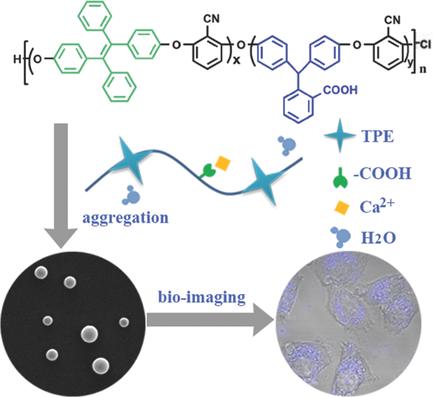当前位置:
X-MOL 学术
›
Macromol. Rapid Commun.
›
论文详情
Our official English website, www.x-mol.net, welcomes your feedback! (Note: you will need to create a separate account there.)
Ca2+ Induced Crosslinking of AIE‐Active Polyarylene Ether Nitrile into Fluorescent Polymeric Nanoparticles for Cellular Bioimaging
Macromolecular Rapid Communications ( IF 4.6 ) Pub Date : 2017-09-14 , DOI: 10.1002/marc.201700360 Pan Wang 1 , Kun Jia 1 , Xuefei Zhou 1 , Xiaotian Guan 2 , Lianhui Wang 2 , Yuan Tian 2 , Chunhui Wu 2 , Xiaobo Liu 1
Macromolecular Rapid Communications ( IF 4.6 ) Pub Date : 2017-09-14 , DOI: 10.1002/marc.201700360 Pan Wang 1 , Kun Jia 1 , Xuefei Zhou 1 , Xiaotian Guan 2 , Lianhui Wang 2 , Yuan Tian 2 , Chunhui Wu 2 , Xiaobo Liu 1
Affiliation

|
Biocompatible fluorescent polymeric nanoparticles (FPNs) are promising luminescent probes in cellular bioimaging, while the fabrication of high‐quantum‐yield FPN using nonconjugated heterochain polymers derived from step‐growth polymerization is still in its infancy. Herein, the nonconjugated polyarylene ether nitrile (PEN) is endowed with aggregation‐induced emission (AIE) feature by incorporation of an AIEgen named of 1,2‐di(4‐hydroxyphenyl)‐1,2‐diphenylethene into macromolecular backbone. Furthermore, the AIE‐active PEN is crosslinked into water soluble fluorescent nanospheres showing good biocompatibility and strong emission ≈480 nm with a quantum yield of 21% in the presence of Ca2+, which allows the successful bioimaging of cancer cells. Due to the facile fabrication of FPNs and their effective bioimaging performance, the current work will open the way for the biomedical applications of various high performance polyarylene ethers.
中文翻译:

Ca2 +诱导的AIE活性聚亚芳基醚腈交联到用于细胞生物成像的荧光聚合物纳米粒子中
生物相容性荧光聚合物纳米颗粒(FPN)是细胞生物成像中很有希望的发光探针,而使用逐步生长聚合衍生的非共轭杂链聚合物制备高量子产率FPN仍处于起步阶段。在此,通过将名为1,2-二(4-羟基苯基)-1,2-二苯基乙烯的AIEgen引入大分子骨架,非共轭聚亚芳基醚腈(PEN)具有聚集诱导发射(AIE)的功能。此外,在具有Ca 2+的情况下,具有AIE活性的PEN交联到水溶性荧光纳米球中,该纳米球显示出良好的生物相容性和强发射≈480nm,量子产率为21%,这使得癌细胞能够成功地进行生物成像。由于FPN的制造简便且其有效的生物成像性能,当前的工作将为各种高性能聚亚芳基醚的生物医学应用开辟道路。
更新日期:2017-09-14
中文翻译:

Ca2 +诱导的AIE活性聚亚芳基醚腈交联到用于细胞生物成像的荧光聚合物纳米粒子中
生物相容性荧光聚合物纳米颗粒(FPN)是细胞生物成像中很有希望的发光探针,而使用逐步生长聚合衍生的非共轭杂链聚合物制备高量子产率FPN仍处于起步阶段。在此,通过将名为1,2-二(4-羟基苯基)-1,2-二苯基乙烯的AIEgen引入大分子骨架,非共轭聚亚芳基醚腈(PEN)具有聚集诱导发射(AIE)的功能。此外,在具有Ca 2+的情况下,具有AIE活性的PEN交联到水溶性荧光纳米球中,该纳米球显示出良好的生物相容性和强发射≈480nm,量子产率为21%,这使得癌细胞能够成功地进行生物成像。由于FPN的制造简便且其有效的生物成像性能,当前的工作将为各种高性能聚亚芳基醚的生物医学应用开辟道路。



























 京公网安备 11010802027423号
京公网安备 11010802027423号